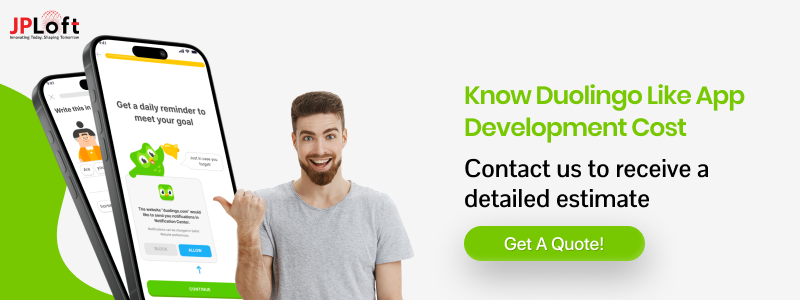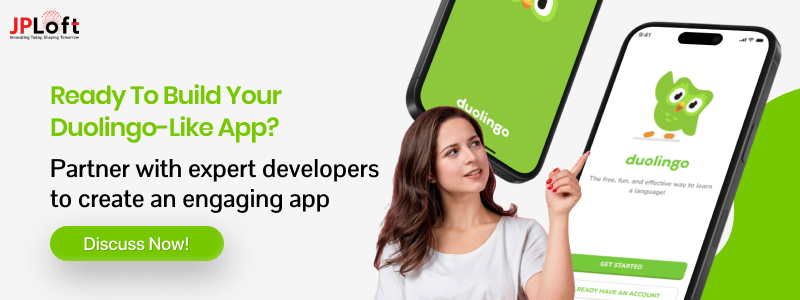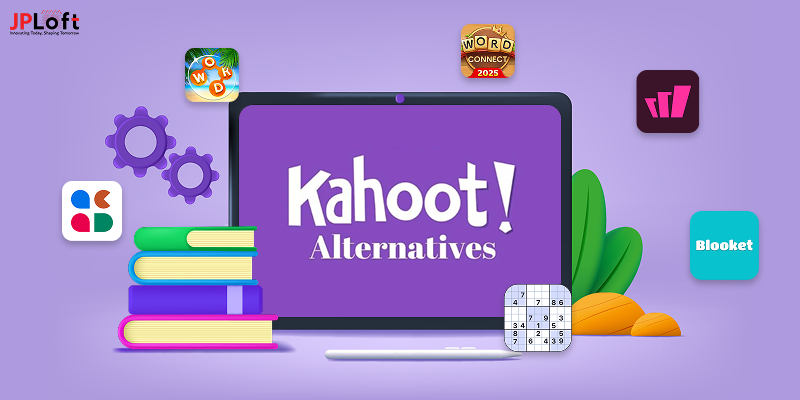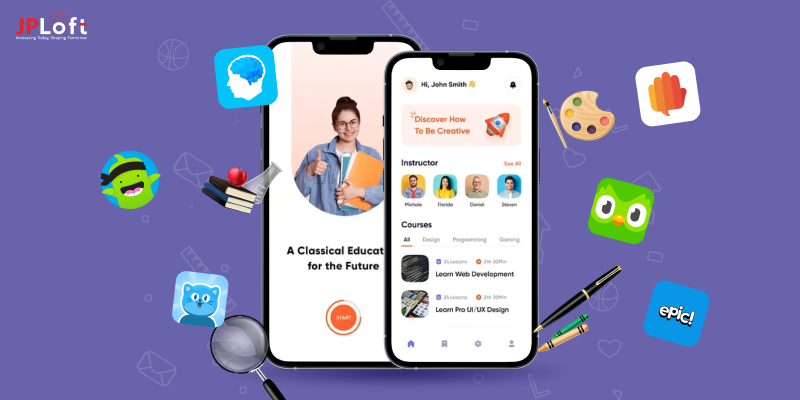Learning a new language has become more accessible and engaging than ever, thanks to apps like Duolingo.
With fun lessons, interactive exercises, and a game-like experience, Duolingo has completely changed the way people learn languages.
If you have ever wondered how to create an app like Duolingo, you are not alone. Many entrepreneurs and developers are exploring ways to build their own language learning apps that are engaging, effective, and user-friendly.
But where do you start? What features make a language learning app successful? And what technologies do you need to develop an app like Duolingo?
In this guide, we will walk you through everything you need to know about how to build an app like Duolingo, from key features and tech stack to design and marketing strategies. Let’s dive in and turn your language learning app idea into reality!
What is Duolingo App?
The language learning app Duolingo is very popular, and it has classes in more than 40 languages on both its website and mobile app. Luis von Ahn and Severin Hacker started Duolingo in 2011. Their goal is to make education free and open to everyone. The app uses game-like lessons to keep users interested, which makes learning a language fun and useful.
Here are some pretty amazing numbers about how popular Duolingo is:
-
- Before it even came out, Duolingo was already a big hit. The team started a secret test in November 2011, and 300,000 people had signed up on a waitlist in just one month. Over 10 million people got the app in its first year.
- Duolingo was the most popular language learning app globally in July 2024, with about 14.3 million downloads.
- Duolingo’s revenue experienced an upward trend between 2020 and 2024, hitting a value of more than 178 million U.S. dollars during the second quarter of 2024.
- Duolingo has grown its paid users by around 50% per year. It surpassed eight million in 2024.
- As of the third quarter of 2024, about 113 million people were using the Duolingo app every month. This marked an increase of around 10 percent compared to the previous quarter.
After learning about its amazing journey and knowing impressive market statistics, let's move on to know the working of the app.
How Does the Duolingo App Work?
If you are wondering how to create a language learning app like Duolingo, the first step is to understand how the app works from a user’s perspective.
Duolingo has an easy, engaging, and gamified learning process that makes language learning fun and approachable.
Below is a step-by-step breakdown of how people interact with the app.
1. Registration and User Sign-Up
When users first open the app, they are welcomed with a simple and easy signup process. They can sign up using their email, Google, Facebook, or Apple ID.
Once registered, the app asks a few questions to adjust the learning experience, such as the chosen language, learning goals, and daily study time.
Key Takeaway: A smooth onboarding experience makes users feel relaxed and pushes them to start learning instantly.
2. Choosing a Language and Setting Goals
Users select the language they want to learn from a wide range of available options.
The app also asks them about their learning goals, if they want to study casually, for travel, work, or fluency. Based on their responses, Duolingo suggests a personalized learning path with daily targets.
Key Takeaway: Goal-setting improves user motivation and helps maintain consistency.
3. Placement Test or Beginner Lessons
New learners can either start from the basics or take a placement test to determine their current skill level.
This test includes listening, reading, and translation exercises. Based on the results, the app assigns an appropriate starting point in the course.
Key Takeaway: A placement test personalizes the learning journey, ensuring users don’t waste time on lessons they already know.
4. Starting Interactive Lessons
Once users begin their lessons, they go through a series of interactive exercises, including:
-
- Translation Tasks: Converting words and sentences from one language to another
- Listening Exercises: Hearing and understanding spoken language
- Pronunciation Practice: Speaking words and sentences with speech recognition technology
- Grammar & Vocabulary Activities: Learning new words and sentence patterns
Lessons are short and made to fit into a user’s daily routine, making learning effective and doable.
Key Takeaway: Short, engaging lessons improve interest and prevent users from feeling overwhelmed.
5. Tracking Progress and Earning Rewards
Duolingo keeps users inspired through gamification features like XP points, runs, badges, and leaderboards.
As they finish lessons, users earn points, open new levels, and compete with friends. The app also tells them to practice regularly to keep their learning streak.
Key Takeaway: Gamification motivates users to stay consistent and makes learning feel like a game rather than a job.
6. Reviewing and Revising Learned Content
Duolingo uses spaced repetition, a scientifically proven method, to strengthen previously learned words and ideas. Users receive prompts to practice older lessons, ensuring they keep information long-term.
Key Takeaway: Regular review improves memory and stops forgetting.
7. Unlocking Advanced Features and Certification
As users improve, they can unlock advanced features like Duolingo Stories, Podcasts, and AI-powered chatbots to practice real-life talks.
Duolingo also offers certifications for language skills, which users can add to their resumes or social accounts.
Key Takeaway: Offering real-world applications improves the app’s value and keeps users interested for the long run.
After this section, you are well-informed about Duolingo, its market status, and working. Now it's time to find out, “ How to develop an app like Duolingo?” and learn about the process involved.
Step-by-Step Guide to Create a Language Learning App Like Duolingo
The e-learning market has experienced amazing growth in recent years. In 2021, the global e-learning market was estimated at approximately $214.26 billion and is expected to grow at a CAGR of 20.5% from 2022 to 2030.
This rise is driven by the growing acceptance of digital learning platforms across educational institutions and business sectors, fueled by the demand for online learning and upskilling opportunities.
Duolingo, a top player in this area, has greatly added to this upward trend. In 2023, Duolingo recorded revenues of $531 million, showing a 43.7% increase from the previous year. This impressive growth shows the rising acceptance and utility of mobile language learning apps.
The future looks promising for language learning apps, with the market expected to continue its expansion. As more learners turn to digital platforms for education, understanding how to create apps like Duolingo becomes essential.
In the following section, we will delve into the language learning app development process.
Step 1: Conduct Market Research and Define Your Target Audience
Before you develop an app like Duolingo, perform detailed market research.
Who is your target audience? Are you aiming at students, workers, tourists, or casual learners?
You can build a language learning app like Duolingo that meets their needs by understanding their learning interests.
Analyze top language learning apps such as Duolingo, Babbel, and Rosetta Stone to find their strengths and flaws. Check user reviews to see which features they like and where they have problems.
Additionally, assess market trends, including the demand for particular languages and chosen learning methods. With the help of this research, you can create an app like Duolingo on the go that meets needs in the market and is unique.
Step 2: Define Your App’s Unique Value Proposition
To successfully create an education app like Duolingo, you need to give something special.
While Duolingo excels in gamification, AI-driven tailoring, and microlearning, your app should have unique features that make it more appealing.
For instance, you could combine AI-powered voice recognition for real-time pronunciation correction, offer culture learning modules, or introduce live language exchange features where users can practice with native speakers.
A strong value proposition ensures that when you build an app like Duolingo, it doesn’t just copy existing solutions but instead brings innovation and meets users' unmet needs.
Step 3: Decide the Core Features
The success of your app rests on the features you offer.
When you create a language learning app like Duolingo, focus on educational features that increase interest, retention, and personalization.
Essential features include engaging lessons, gamification elements like badges and leaderboards, AI-driven progress tracking, speech recognition for pronunciation improvement, and real-time chatbots for interaction.
Additionally, adding offline mode, daily learning streaks, and social sharing choices can significantly boost user drive.
To make an app like Duolingo, ensure that the learning experience is fun, adaptive, and accessible, keeping users involved and committed to long-term language learning.
Step 4: Determine Your App Development Platform
Choosing the right platform is important when you build an app like Duolingo.
The main choices are iOS, Android, or cross-platform development. If you aim for a larger audience, opting for a cross-platform framework like Flutter or React Native is perfect.
This ensures your app is available on multiple devices while cutting mobile development costs and time.
On the other hand, if you want to develop a language learning app like Duolingo with platform-specific improvements, you can choose native development using Swift for iOS and Kotlin for Android.
Your choice should align with your target audience's device tastes and the budget you have given for Duolingo clone app development.
Step 5: Choose the Right Tech Stack
Selecting the right technology stack is a crucial step when you create an app like Duolingo.
The tech stack decides your app’s scalability, speed, and ability to combine advanced features. A well-optimized tech stack ensures a smooth user experience, fast loading times, and high data security.
To develop a language learning app like Duolingo, you need a mix of front-end and back-end technologies, databases for saving user progress, and AI tools for engaging learning experiences.
Choosing the wrong tech stack can lead to speed problems, security flaws, and difficulties in future updates. Your choice will rely upon if you are developing for a single platform (iOS or Android) or going for a cross-platform option.
An experienced mobile app development company which can save you from selecting the wrong tech stack and help you to get the best outcome.
Below is a breakdown of the key tools you should consider to build an e-learning app like Duolingo:
|
Component |
Technologies & Tools |
Purpose |
|
Frontend (Cross-Platform) |
React Native, Flutter |
Enables faster development for both iOS and Android with a single codebase |
|
Frontend (Native - iOS) |
Swift |
Optimized for iOS development with better performance and security |
|
Frontend (Native - Android) |
Kotlin |
Ideal for Android apps, providing robust security and performance |
|
Backend Development |
Node.js, Django |
Manages app logic, user authentication, and API connections |
|
Database |
PostgreSQL, Firebase |
Stores user progress, lessons, and app data securely |
|
Speech Recognition & AI |
Google Cloud Speech-to-Text, Amazon Polly |
Enhances pronunciation correction and real-time language feedback |
|
Cloud Storage & Hosting |
AWS, Google Cloud, Firebase Cloud Storage |
Ensures scalability, secure data storage, and fast content delivery |
|
Analytics & User Insights |
Google Analytics, Mixpanel |
Tracks user engagement, progress, and app performance for improvements |
Step 6: Design a User-Friendly Interface
A well-designed user interface is important when you create an app like Duolingo.
Your education app design should be simple, entertaining, and easy so users of all ages can explore easily. The color scheme, fonts, and animations should make learning feel fun rather than overwhelming.
Use interactive elements like progress bars, icons, and animations to keep user involvement. Additionally, ensure that the app style is mobile-friendly and adjusts to different screen sizes.
When you develop an education app like Duolingo, choosing UX/UI best practices will enhance memory and encourage users to return daily for lessons.
Below is a table highlighting the key UI/UX components and their part to create a language learning app like Duolingo.
|
Component |
Description |
|
Minimalist Design |
A clean and clutter-free interface that helps users focus on learning rather than unnecessary distractions. |
|
Intuitive Navigation |
Easy-to-use menus, simple buttons, and clear progress indicators ensure users can navigate effortlessly. |
|
Interactive Animations |
Engaging animations and transitions that provide feedback on user actions and enhance the learning experience. |
|
Responsive Design |
A mobile-friendly layout that adapts seamlessly to various screen sizes and devices. |
|
Dark & Light Modes |
Offering users the ability to switch between modes for a comfortable learning experience. |
|
Microinteractions |
Small, engaging UI elements like button haptics, sound effects, or emoji reactions to enhance user engagement. |
|
Multilingual Support |
Ensuring the app’s interface is available in multiple languages to cater to diverse users. |
Step 7: Start Development of Your App
Once the research, design, and tech stack selection are finished, it's time to develop an app like Duolingo.
The development method starts with building an MVP (Minimum Viable Product), which includes the core features such as live lessons, gamification, and AI-driven tracking.
The development part is split into front-end and back-end work. Developers will combine APIs, set up databases, and ensure smooth operation across devices.
It's important to follow agile development methods, allowing iterative testing and constant growth.
As you create a mobile app, keeping code quality and security is important to avoid data breaches and performance issues.
Step 8: Test Your App Thoroughly
Before launching, you must perform rigorous testing to ensure your app works easily.
When you make an app like Duolingo, testing should cover UI/UX, speed, security, and compatibility across different platforms.
Usability testing helps identify any confusing elements in navigation, while functional testing ensures all features, speech recognition, tests, and progress tracking, work as expected. Performance testing checks loading speed and computer reaction times, ensuring users don’t experience lag.
A well-tested app lowers errors and improves the overall user experience, making it more likely to win in the competitive market
Step 9: Launch and Market Your App
After months of development and testing, it’s time to launch your app. Simply building an app like Duolingo is not enough; you need a strong marketing plan to attract users.
Start with App Store Optimization (ASO) by using relevant terms in your app title, description, and metadata to improve exposure. Social media efforts, influencer collaborations, and content marketing can help create buzz around your app.
Additionally, giving free trials or referral rewards can promote word-of-mouth marketing. If you strategically promote your app, you can easily build a language learning app like Duolingo that gets traction quickly.
By following these steps, you can build an education app like Duolingo that stands out, engages users, and offers an effective and enjoyable learning experience.
However, the development process makes you wonder about the cost of the language learning app. Let’s dive in to know about the development cost and time.
How Much Does It Cost to Develop an App Like Duolingo?
Developing an education app takes significant planning, resources, and funding. The cost largely relies on the app’s complexity, features, platform (iOS, Android, or both), and the development team’s experience.
A language learning app like Duolingo offers engaging features such as gamification, AI-driven customized lessons, progress tracking, and more.
These education app features demand advanced technology and development time, affecting the total education app development cost.
► Total Estimated Cost
-
Basic Language Learning App: $25,000 – $100,000
-
Advanced Duolingo-Like App: $80,000 – $200,000+
To give you a clear picture, here’s a projected breakdown of the cost to develop an app like Duolingo based on key parameters:
|
Development Aspect |
Cost Estimate |
Details |
|
App Design |
$10,000 – $20,000 |
Includes UI/UX design, wireframes, and user interface development. |
|
Frontend & Backend Development |
$25,000 – $50,000 |
Covers coding, API integration, and database management for smooth app functionality. |
|
Gamification Features |
$15,000 – $30,000 |
Development of game-like elements such as streaks, rewards, leaderboards, and progress bars. |
|
AI & Personalization |
$20,000 – $40,000 |
Implementation of AI algorithms for adaptive learning and personalized lesson plans. |
|
Language Modules & Content |
$15,000 – $30,000 |
Development of language-specific lessons, quizzes, and content customization. |
|
Testing & QA |
$5,000 – $10,000 |
Ensuring the app runs bug-free and performs seamlessly across devices. |
|
Maintenance & Updates |
$2,000 – $5,000 (monthly) |
Ongoing costs for updates, new features, and resolving user-reported issues. |
|
Marketing & Launch |
$10,000 – $25,000 |
Expenses for app promotion, branding, and initial user acquisition campaigns. |
► Timeframe for Duolingo Like App Development
For a fully functional Duolingo-like app, it can take 6–12 months or more depending on complexity and team size.
This timeline is indicative and can be adjusted based on project needs and resources.
|
Phase |
Timeframe |
|
Research & Planning |
2–4 Weeks |
|
UI/UX Design |
4–6 Weeks |
|
Development (MVP) |
12–16 Weeks |
|
Advanced Features |
8–12 Weeks |
|
Testing |
6–8 Weeks |
|
Launch Preparation |
2–3 Weeks |
|
Launch & Feedback |
1–2 Weeks |
|
Post-Launch Updates |
Ongoing |
Best Language Learning Apps Like Duolingo
Here is a list of popular language learning apps similar to Duolingo, along with their download numbers:
|
App Name |
Downloads |
Description |
|
Memrise |
10M+ |
Utilizes user-generated content and spaced repetition for vocabulary building |
|
Babbel |
50M+ |
Focuses on conversation skills with courses created by language experts. |
|
Lingodeer |
10M+ |
Specializes in Asian languages with structured lessons and interactive exercises. |
|
Busuu |
10M+ |
Offers courses in 14 languages with practice opportunities with native speakers. |
|
Rosetta Stone |
10M+ |
Provides immersive language courses focusing on real-world conversations. |
|
Mondly |
10M+ |
Features bite-sized lessons in 41 languages with speech recognition technology |
|
Drops |
5M+ |
Emphasizes vocabulary learning through visual association and quick, fun games. |
Key Features of a Duolingo-Like App
To develop an app similar to Duolingo, you must focus on its standout features that make language learning effective and interesting.
Duolingo's success lies in its ability to provide a structured yet fun learning experience through gamification, personalization, and engaging material.
Below are some of the standout features that contribute to its broad success and user retention.
► Regular Tests
One of the biggest reasons for Duolingo’s success is its focus on grading.
To create a language learning app like Duolingo, you need to adopt regular tests that help users track their learning progress.
These tests evaluate vocabulary, grammar, pronunciation, and listening skills, ensuring learners repeat their knowledge at every step.
► Byte-Sized Learning Modules
Short and organized lessons are a must when you build an app like Duolingo.
Rather than overwhelming users with lengthy material, Duolingo offers micro-learning modules that fit easily into busy plans.
These small yet effective lessons make it easier for users to stay steady while motivating learners to come back daily.
► Interactive Lessons
Developing language learning apps requires lessons that must be interactive and interesting.
Instead of silent learning, Duolingo uses gamified activities such as matching words, fill-in-the-blanks, and audio-based pronunciation practice.
These factors make learning fun while improving learning and memory.
► Progress Tracking
A well-structured progress tracking system is important when building an app like Duolingo.
Duolingo keeps users inspired by showing streaks, XP points, skill mastery levels, and milestone successes. Visualizing their change helps users stay motivated and committed to their language-learning goals.
► Scaffolded Support
Scaffolded learning is a teaching method where new ideas are introduced gradually while reinforcing previous lessons.
Duolingo takes this method by ensuring that users revisit past lessons before moving on to more complicated topics. This organized learning path builds trust and stops users from feeling overwhelmed.
► Personalized Learning Paths
Personalization is key while developing language learning apps. The app reacts to user success and tailors lessons accordingly. AI-driven algorithms study a learner’s skills and flaws, giving customized exercises based on their progress.
A personalized method ensures that users stay pushed without feeling discouraged, making learning more efficient and fun.
Besides these standout features, Duolingo includes various other core functionalities that enhance user engagement and retention.
Here are some additional must-have features when creating a Duolingo-like app:
|
Feature |
Description |
|
Push Notifications |
Timely reminders encourage users to maintain learning streaks. |
|
Multi-Language Support |
Offers lessons in various languages, catering to a global audience. |
|
Voice Recognition Technology |
Enables users to practice pronunciation with real-time feedback. |
|
Offline Mode |
Allows users to download lessons and learn without an internet connection. |
|
Social Features |
Leaderboards and challenges encourage friendly competition. |
|
Subscription Plans |
A freemium model offers free and premium features for monetization. |
|
Duolingo Stories |
Interactive reading exercises improve comprehension skills. |
|
Smart Tips and Explanations |
Bite-sized grammar explanations simplify complex rules. |
|
In-App Shop & Virtual Currency |
Users earn rewards and unlock perks, enhancing engagement. |
|
AI-Driven Chatbots |
Realistic conversations help users practice language skills. |
|
Placement Tests |
Custom tests determine the user's language proficiency level. |
|
Real-World Challenges |
Virtual or live events allow users to practice with others. |
|
Crown System for Skill Mastery |
Unlocking advanced lessons motivates deeper learning. |
|
Math Learning Module |
Gamified math exercises expand the app’s learning scope. |
|
Music Learning Module |
Interactive music lessons introduce users to rhythm and melodies. |
The success of your app is not just decided by its features; other factors like the right business models, advanced security measures, and usability also play a key role. We have prepared a list of common monetisation strategies implemented by language learning apps.
Monetization Strategies for an App Like Duolingo
When you develop an e-learning app like Duolingo, choosing the right business plan is important for generating revenue and ensuring the app’s sustainability.
Duolingo’s success lies not only in its user-friendly design but also in its diverse business plan that speaks to a wide range of users.
Here are some of the key business models you can consider for your own language learning app like Duolingo:
1] Freemium Model
The freemium model is a popular choice in the e-learning area, and Duolingo successfully uses this model. In this arrangement, users can access basic features for free but must pay for premium material or features.
How it works:
-
- Basic language classes, practice lessons, and tests are free to access.
- Premium benefits like an ad-free experience, offline access, and advanced lessons are available with a membership.
Example: Duolingo Plus gives extra features like an ad-free experience, offline access, and progress tracking for a monthly or annual fee.
2] Advertisement Model
Duolingo makes a large portion of its revenue through ads. By showing ads during free lessons or between exercises, the app monetizes its huge user base.
How it works:
-
- Free users will view ads between lessons or activities.
- Premium users who have subscribed to Duolingo Plus will experience an ad-free journey.
3] In-App Purchases (IAP)
In-app purchases (IAP) are another great business plan for language learning apps. This model works by giving extra features, tools, or material for users who wish to improve their learning experience.
How it works:
-
- Users can buy extra lessons, learning packs, or individual coaching sessions within the app.
- This model offers one-time purchases without the need for regular subscriptions.
4] Corporate Partnerships & Licensing
A B2B (business-to-business) model includes partnering with businesses and educational institutions to offer language learning programs for workers or students.
How it works:
-
- Companies and universities can purchase licenses to provide access to your app to their employees or students.
- Duolingo has ventured into this model by collaborating with companies for workforce language training and offering tailored programs.
5] Certification and Credentialing
Language learning apps like Duolingo can offer official awards upon successful finishing of language classes. These certificates hold value for users who wish to showcase their skills in job applications, school activities, or personal growth.
How it works:
-
- Offer certificates for each level or training.
- Users can pay a fee to receive an official certificate upon finishing a language lesson.
6] Language Coaching & Tutoring
Offering one-on-one language teaching or training is another business plan that can be added to your Duolingo-like app. By offering personalized coaching lessons, you can create an extra premium service.
How it works:
-
- Users can book one-on-one lessons with native speakers or qualified teachers.
- Charges are usually based on the length and skill of the tutor.
7] Sponsorships and Partnerships
Sponsorships from brands related to language learning, school, or travel can also bring in income. Brands may want to sponsor material or individual courses, especially if they align with their target community.
How it works:
-
- Collaborate with language learning material makers, tour companies, or other related businesses.
- Brands may pay to support specific lessons, tasks, or events within the app.
Developing a mobile app is not as easy as it seems. The next section will inform you about the challenges that come with the Duolingo-like app development process.
Challenges You May Face While Developing a Duolingo-Like App
Creating a language learning app like Duolingo involves more than implementing basic e-learning features.
There are specific challenges that developers and businesses may face while building such an app. Below are the challenges and potential solutions to overcome them.
1. Maintaining User Engagement
Challenge: Language learning can be a monotonous process, leading to user drop-offs. Without engaging features, users may lose interest in the app.
Solution:
-
- Incorporate gamification elements such as daily streaks, badges, and leaderboards.
- Add reminders and notifications for users to practice consistently.
- Introduce new, interactive content regularly, like quizzes, games, and speaking challenges.
By focusing on gamified and personalized experiences, you can enhance user retention in your app like Duolingo.
2. Building an Adaptive Learning System
Challenge: Offering personalized content based on the user’s language proficiency can be complex to implement.
Solution:
-
- Use AI and machine learning algorithms to analyze user behavior and adapt the curriculum dynamically.
- Employ placement tests to identify the user’s current level and recommend suitable lessons.
- Monitor progress and adjust lesson difficulty accordingly.
A robust adaptive system is crucial to differentiate your app and make it effective for learners.
3. Achieving Accurate Speech Recognition
Challenge: Implementing voice recognition technology for multiple languages can be expensive and prone to inaccuracies.
Solution:
-
- Use advanced APIs like Google Cloud Speech-to-Text or Microsoft Azure Cognitive Services for better accuracy.
- Train your system with diverse datasets to improve recognition of different accents and dialects.
- Provide feedback to users on their pronunciation with real-time correction tools.
Accurate speech recognition is a standout feature that can help you compete with other language learning mobile apps like Duolingo.
4. Managing Multilingual Content
Challenge: Adding multiple languages with comprehensive lessons and maintaining their quality can be resource-intensive.
Solution:
-
- Collaborate with professional linguists and native speakers to ensure accuracy and cultural relevance.
- Use scalable content management systems (CMS) to manage large datasets efficiently.
- Start with a few popular languages and gradually expand the library.
A well-structured backend and localized content are essential for creating a Duolingo clone app with a global reach.
5. Scalability Issues
Challenge: Handling a growing user base without performance issues can be a significant challenge for developers.
Solution:
-
- Use cloud services like AWS, Google Cloud, or Microsoft Azure for scalable infrastructure.
- Optimize code and database queries to reduce load times.
- Perform rigorous testing for high traffic scenarios.
Scalability ensures that your language learning app like Duolingo can grow alongside your user base.
6. Ensuring Data Privacy and Security
Challenge: Collecting user data, including personal information and speech recordings, can raise privacy concerns. App security measures should be the priority to prevent any scams or frauds.
Solution:
-
- Implement data encryption for secure storage and transmission.
- Comply with regulations like GDPR, HIPAA, or CCPA depending on your target market.
- Clearly communicate your privacy policies to users.
- A secure app builds trust and ensures long-term user retention.
Build a Language Learning App Like Duolingo With JPLoft
Looking to create an app like Duolingo that revolutionizes education?
JPLoft is your trusted education app development company for building unique and feature-rich language learning apps.
With our expertise in e-learning app development, we offer solutions equipped with gamified lessons, AI-driven personalization, speech recognition, and more.
If you are making a Duolingo-like app or improving the existing one, we ensure a smooth user experience suited to your vision.
Our end-to-end development services, including UI/UX design, strong backend, and scalable architecture, ensure success in the competitive app market.
Partner with JPLoft and turn your ideas into a cutting-edge, profitable reality today!
Final Words
In this fast changing digital era, language learning apps are transforming the way people gain new skills and knowledge.
By giving ease, flexibility, and personalized learning experiences, apps like Duolingo have set a standard for e-learning success. Building a similar app takes a commitment to quality, user-centric design, and cutting-edge technology.
Aspiring developers and companies can take inspiration from Duolingo’s journey, focusing on what makes it unique is its gamification, flexible learning paths, and a community-driven approach.
With proper planning, creativity, and execution, your language learning app can become a game changer in the e-learning industry, catering to a global audience eager to learn and grow.
FAQs
Duolingo is a widely-used language-learning app known for its gamified approach to education. It offers bite-sized lessons, engaging exercises, and features like streaks and rewards to make learning fun and interactive.
To develop an app like Duolingo, you'll need to focus on user-centric design, gamification, and adaptive learning features. Key steps include market research, feature selection, choosing the right tech stack, and partnering with experienced developers.
Features include gamification, adaptive learning paths, progress tracking, push notifications, offline mode, regular practice sessions, scaffolded support, and an in-app shop.
The cost depends on various factors such as features, complexity, platform, and location of the development team. It can range from $30,000 to $200,000 or more for a fully functional app.
Yes, other popular apps include Babbel, Rosetta Stone, Memrise, Busuu, and Mondly, each offering unique features and content.
The development timeline varies based on app complexity, features, and team size. Typically, it can take 6–12 months for an MVP and up to 18 months for a fully functional app.













Share this blog